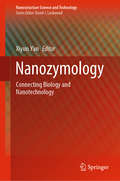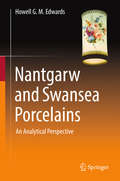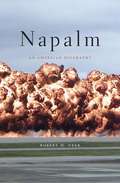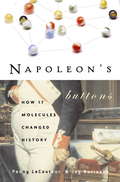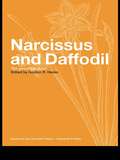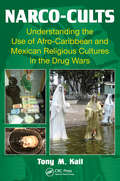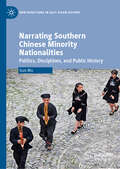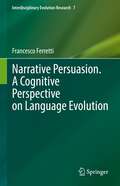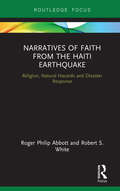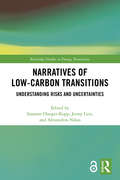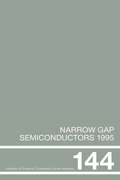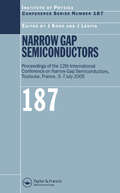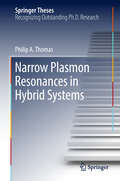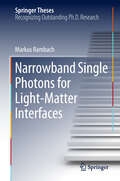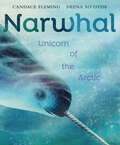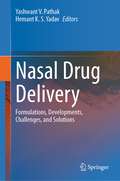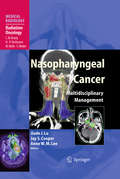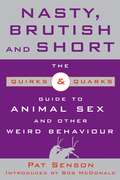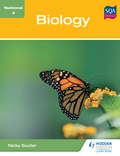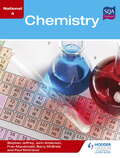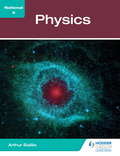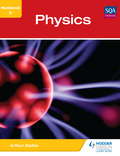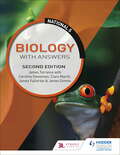- Table View
- List View
Nanozymology: Connecting Biology and Nanotechnology (Nanostructure Science and Technology)
by Xiyun YanThis book introduces the new concept of “nanozyme”, which refers to nanomaterials with intrinsic enzymatic activity, rather than nanomaterials with biological enzymes incorporated on the surface. The book presents the cutting-edge advances in nanozyme, with emphasis on state-of-the-art applications in many important fields, such as in the biomedical fields and for environmental protection. The nanozyme is a totally new type of artificial enzyme and exhibits huge advantages over natural enzymes, including greater stability, low cost, versatility, simplicity, and suitability for industry. It is of interest to university researchers, R&D engineers, as well as graduate students in nanoscience and technology, and biology wishing to learn the core principles, methods, and the corresponding applications of “nanozyme”.
Nantgarw and Swansea Porcelains: A Forensic Re-evaluation
by Howell G.M. EdwardsThis book gives a detailed account of the holistic research carried out on the analytical data obtained historically on the products of the Nantgarw and Swansea porcelain manufactories which existed for a few years only during the second decade of the 19th Century. A background to the establishment of the two factories, which are linked through the persons of the enigmatic William Billingsley and his kiln manager, Samuel Walker, involves the sourcing of their raw materials and problems associated with the manufacture and distribution of the finished products. A description of the minerals and additives used in porcelain production is recounted to set the scene for the critical evaluation of the comprehensive analytical data which have been published on Nantgarw and Swansea porcelains. For the first time, the author has adopted a nondestructive technique, Raman spectroscopy, to interrogate perfect samples of Nantgarw and Swansea porcelain, as well as a selection of shards from an archaeological excavation carried out at a waste dump at the Nantgarw China Works site. Following these experiments, several questions relating to the porcelain bodies of Swansea and Nantgarw china can be answered and a protocol established for the preliminary evaluation of items of suspect attribution to confirm or not the correctness of their assignment to these Welsh porcelain factories.
Napalm: An American Biography
by Robert M. NeerNapalm, incendiary gel that sticks to skin and burns to the bone, came into the world on Valentine's Day 1942 at a secret Harvard war research laboratory. On March 9, 1945, it created an inferno that killed over 87,500 people in Tokyo-more than died in the atomic explosions at Hiroshima or Nagasaki. It went on to incinerate sixty-four of Japan's largest cities. The Bomb got the press, but napalm did the work. After World War II, the incendiary held the line against communism in Greece and Korea-Napalm Day led the 1950 counter-attack from Inchon-and fought elsewhere under many flags. Americans generally applauded, until the Vietnam War. Today, napalm lives on as a pariah: a symbol of American cruelty and the misguided use of power, according to anti-war protesters in the 1960s and popular culture from Apocalypse Now to the punk band Napalm Death and British street artist Banksy. Its use by Serbia in 1994 and by the United States in Iraq in 2003 drew condemnation. United Nations delegates judged deployment against concentrations of civilians a war crime in 1980. After thirty-one years, America joined the global consensus, in 2011. Robert Neer has written the first history of napalm, from its inaugural test on the Harvard College soccer field, to a Marine Corps plan to attack Japan with millions of bats armed with tiny napalm time bombs, to the reflections of Phan Thi Kim Phuc, a girl who knew firsthand about its power and its morality.
Napoleon's Buttons
by Jay Burreson Penny Le CouteurNapoleon's Buttons is the fascinating account of seventeen groups of molecules that have greatly influenced the course of history. These molecules provided the impetus for early exploration, and made possible the voyages of discovery that ensued. The molecules resulted in grand feats of engineering and spurred advances in medicine and law; they determined what we now eat, drink, and wear. A change as small as the position of an atom can lead to enormous alterations in the properties of a substance-which, in turn, can result in great historical shifts. With lively prose and an eye for colorful and unusual details, Le Couteur and Burreson offer a novel way to understand the shaping of civilization and the workings of our contemporary world.
Narcissus and Daffodil: The Genus Narcissus (Medicinal And Aromatic Plants - Industrial Profiles Ser.)
by Gordon R. HanksNarcissus and Daffodil is the first book to provide a complete overview of the genus Narcissus. Prized for centuries in western Europe as an ornamental plant, it has recently attracted attention as a source of potentially valuable pharmaceuticals. In eastern European countries, however, Narcissus and other Amaryllidaceae have been valued as a sourc
Narco-Cults: Understanding the Use of Afro-Caribbean and Mexican Religious Cultures in the Drug Wars
by Tony M. KailThose who know about how spirituality plays into the world of drug smuggling have likely heard of Santa Muerte, Jesus Malverde, and Santer but the details of the more obscure African religions and Latin American folk saints and cults often remain a mystery. While the vast majority of these religions are practiced by law-abiding citizens with no co
Narcotics: Nature's Dangerous Gifts
by Norman TaylorInformation on marijuana, opium, morphine, heroin, coca, cocaine, alcohol, tobacco, ololiuqui, peyotl (mescaline), pituri, fly agaric, caapi, kava, betel, coffee, chocolate and tea.
Narrating Southern Chinese Minority Nationalities: Politics, Disciplines, and Public History (New Directions in East Asian History)
by Guo WuBased on fieldwork, archival research, and interviews, this book critically examines the building of modern Chinese discourse on a unified yet diverse Chinese nation on various sites of knowledge production. It argues that Chinese ideology on minority nationalities is rooted in modern China's quest for national integration and political authority. However, it also highlights the fact that the complex process of conceptualizing, investigating, classifying, curating, and writing minority history has been fraught with disputes and contradictions. As such, the book offers a timely contribution to the current debate in the fields of twentieth-century Chinese nationalism, minority policy, and anthropological practice.
Narrative Persuasion. A Cognitive Perspective on Language Evolution (Interdisciplinary Evolution Research #7)
by Francesco FerrettiThis book explores the evolutionary and cognitive foundations of human communication, focusing on narrative as its distinctive dimension. Within a framework of continuity with both the communication of our hominin predecessors and that of non-human animals, the book is about a twofold proposal. It includes the idea that (human and animal) communication has an intrinsically persuasive nature along with the hypothesis that humans developed narrative forms of communication in order to enhance their persuasive abilities. In this view, narrative persuasion becomes the feature that distinguishes human communication from animal communication. The study of the transition from animal communication to language addresses both the selective pressures that led communication for persuasive purposes to take a narrative form and the cognitive architectures and expressive systems that enabled our ancestors to cope with the selective pressures of persuasive/narrative-based communication. Language evolution is interdisciplinary, even from the specific perspective of evolutionary pragmatics chosen here. Therefore, this book is intended for researchers working in fields such as cognitive sciences, philosophy, evolutionary biology, cognitive psychology, and primatology. It also represents a valuable resource for advanced students in cognitive sciences, linguistics, and philosophy.
Narratives of Faith from the Haiti Earthquake: Religion, Natural Hazards and Disaster Response (Routledge Focus on Religion)
by Roger Philip Abbott Robert S. WhiteThis book presents an in-depth ethnographic case study carried out in the years following the 2010 Haiti earthquake to present the role of faith beliefs in disaster response. The earthquake is one of the most destructive on record, and the aftermath, including a cholera epidemic and ongoing humanitarian aid, has continued for years following the catastrophe. Based on dozens of interviews, this book gives primacy to survivors’ narratives. It begins by laying out the Haitian context, before presenting an account of the earthquake from survivors’ perspectives. It then explores in detail how the earthquake affected the religious, mainly Christian, faith of survivors and how religious faith influenced how they responded to, and are recovering from, the experience. The account is also informed by geoscience and the accompanying "complicating factors." Finally, the Haitian experience highlights the significant role that religious faith can play alongside other learned coping strategies in disaster response and recovery globally. This book contributes an important case study to an emerging literature in which the influence of both religion and narrative is being recognised. It will be of interest to scholars of any discipline concerned with disaster response, including practical theology, anthropology, psychology, geography, Caribbean studies and earth science. It will also provide a resource for non-governmental organisations.
Narratives of Low-Carbon Transitions: Understanding Risks and Uncertainties (Routledge Studies in Energy Transitions)
by Jenny Lieu Susanne Hanger-Kopp Alexandros Nikas"The Open Access version of this book, available at https://doi.org/10.4324/9780429458781, has been made available under a Creative Commons Attribution-Non Commercial-No Derivatives 4.0 license." This book examines the uncertainties underlying various strategies for a low-carbon future. Most prominently, such strategies relate to transitions in the energy sector, on both the supply and the demand side. At the same time they interact with other sectors, such as industrial production, transport, and building, and ultimately require new behaviour patterns at household and individual levels. Currently, much research is available on the effectiveness of these strategies but, in order to successfully implement comprehensive transition pathways, it is crucial not only to understand the benefits but also the risks. Filling this gap, this volume provides an interdisciplinary, conceptual framework to assess risks and uncertainties associated with low-carbon policies and applies this consistently across 11 country cases from around the world, illustrating alternative transition pathways in various contexts. The cases are presented as narratives, drawing on stakeholder-driven research efforts. They showcase diverse empirical evidence reflecting the complex challenges to and potential negative consequences of such pathways. Together, they enable the reader to draw valuable lessons on the risks and uncertainties associated with choosing the envisaged transition pathways, as well as ways to manage the implementation of these pathways and ultimately enable sustainable and lasting social and environmental effects. This book will be of great interest to students, scholars, and practitioners of environmental and energy policy, low-carbon transitions, renewable energy technologies, climate change action, and sustainability in general.
Narrow Gap Semiconductors 1995: Proceedings of the Seventh International Conference on Narrow Gap Semiconductors, Santa Fe, New Mexico, 8-12 January 1995 (Institute Of Physics Conference Ser. #144)
by J L RenoNarrow Gap Semiconductors 1995 contains the invited and contributed papers presented at the Seventh International Conference on Narrow Gap Semiconductors, held in January 1995. The invited review papers provide an overview and the contributed papers provide in-depth coverage of research results across the whole field.
Narrow Gap Semiconductors: Proceedings of the 12th International Conference on Narrow Gap Semiconductors (Institute of Physics Conference Series)
by J Kono J LéotinThis volume forms a solid presentation in several important areas of NGS research, including materials, growth and characterization, fundamental physical phenomena, and devices and applications. It examines the novel material of InAs and its related alloys, heterostructures, and nanostructures as well as more traditional NGS materials such as InSb, PbTe, and HgCdTe. Several chapters cover carbon nanotubes and spintronics, along with spin-orbit coupling, nonparabolicity, and large g-factors. The book also deals with the physics and applications of low-energy phenomena at the infrared and terahertz ranges.
Narrow Plasmon Resonances in Hybrid Systems
by Philip A. ThomasAdvances in understanding the interactions between light and subwavelength materials have enabled the author and his collaborators to tailor unique optical responses at the nanoscale. In particular, metallic nanostructures capable of supporting surface plasmons can be designed to possess spectrally narrow plasmon resonances, which are of particular interest due to their exceptional sensitivity to their local environment. In turn, combining plasmonic nanostructures with other materials in hybrid systems allows this sensitivity to be exploited in a broad range of applications. In this book the author explores two different approaches to attaining narrow plasmon resonances: in gold nanoparticle arrays by utilising diffraction coupling, and in copper thin films covered by a protective graphene layer. The performance of these resonances is then considered in a number of applications. Nanoparticle arrays are used along with an atomic heterostructure as elements in a nanomechanical electro-optical modulator that is capable of strong, broadband modulation. Strong coupling between diffraction-coupled plasmon resonances and a gold nanoparticle array and guided modes in a dielectric slab is used to construct a hybrid waveguide. Lastly, the extreme phase sensitivity of graphene-protected copper is used to detect trace quantities of small toxins in solution far below the detection limit of commercial surface plasmon resonance sensors.
Narrowband Single Photons for Light-Matter Interfaces (Springer Theses)
by Markus RambachThis book provides a step-by-step guide on how to construct a narrowband single photon source for the integration with atom-based memory systems. It combines the necessary theoretical background with crucial experimental methods and characterisations to form a complete handbook for readers at all academic levels. The future implementation of large quantum networks will require the hybridisation of photonic qubits for communication with quantum memories in the context of information storage. Such an interface requires carefully tailored single photons to ensure compatibility with the chosen memory. The source itself is remarkable for a number of reasons, including being the spectrally narrowest and brightest source of its kind; in addition, it offers a novel technique for frequency stabilisation in an optical cavity, together with exceptional portability. Starting with a thorough analysis of the current literature, this book derives the essential parameters needed to design the source, describes its individual components in detail, and closes with the characterisation of a single photon source.
Narwhal: Unicorn of the Arctic
by Candace FlemingVenture to the Arctic Ocean and discover real life underwater unicorns--narwhals--in this stunningly illustrated nonfiction picture book.You are a narwhal.Shy... Swift... Small...Humans call you unicorn of the Arctic.When winter ice covers the Arctic Ocean, a narwhal pokes his head through a patch of open water, his tusk--a six-foot long tooth--pointed to the sky.Join this mammal as he jousts with another narwhal, floats with his pod, and uses echolocation to find his prey. When warmer weather arrives, he will migrate towards summer ground. But he must be careful! Predators--orcas and polar bears--will be hungry and looking for a meal.... How will the narwhal escape? Will he be able to return to the winter bay? Paired with atmospheric illustrations by debut illustrator Deena So'Oteh, nonfiction master Candace Fleming delivers a picture book, uniquely told in second person, that expertly explores the mysterious and fascinating unicorn of the Arctic.
Nasal Drug Delivery: Formulations, Developments, Challenges, and Solutions
by Yashwant V. Pathak Hemant K. S. YadavThis book addresses the recent trends and clinical research being reported in last 5 to 10 years in the field of nasal drug delivery systems. In recent years, interest in using nasal passage as drug absorption site has received increased attention from formulation scientists. Nasal passages, even though a small surface area of the body as compared to other absorption passage such as Gastrointestinal tract or skin, show significant possibility for drug absorption at a quicker rate. There is also a possibility of delivering drugs to the brain using this passage and targeting drugs through the nasal passage. The book has 19 chapters addressing various aspects of nasal drug delivery systems such as an overview of anatomy and physiology of the nasal passage from a drug delivery point of view to global market opportunities for nasal drug delivery. In between, it addresses various aspects of nasal drug delivery. There are very few titles exclusively dedicated to nasal drug delivery, covering the formulation and developmental aspects, and addressing the challenges and solutions. The primary audiences for the book are graduate students in field of medicine, pharmacy and also various researchers who are working in the area of nasal drug delivery in addition to students who are specializing in field of medicine in ENT. This book provides comprehensive information on all the aspects related to the nasal drug delivery of various drug molecules.
Nasopharyngeal Cancer
by Jay S. Cooper Anne W. Lee Jiade J. LuNasopharyngeal Cancer - Multidisciplinary Management provides a comprehensive account of the current state of knowledge on nasopharyngeal cancer and its multidisciplinary management. The first ten chapters document contain essential background information on subjects such as epidemiology, pathogenesis, molecular biology, pathology, and the use of imaging in diagnosis and staging. Subsequently, the various treatment options and combinations in a range of settings are examined in depth. Detailed attention is given to the roles of concurrent, adjuvant, and neoadjuvant chemotherapy and advanced radiotherapy techniques. Further chapters then explore surgical treatment, follow-up, treatment of metastatic disease, treatment-related complications, and nasopharyngeal cancer in children. This is an important book that will prove essential reading for the radiation oncology community worldwide and meet the need for substantial improvements in knowledge of modern techniques.
Nasty, Brutish, and Short: The Quirks and Quarks Guide to Animal Sex and Other Weird Behaviour
by Pat SensonBirds do it, and bees do it, so do all animals, some of them in weird and wonderful ways. Quirks & Quarks' latest book explores the more bizarre behaviours of more than 100 creatures, from barnacles to Panda bears. The tiny spider that has to tear off one of its two huge sex organs just to be able to get around; the sea slug that produces a powerful love drug and mates with both males and females; the bedbug that stabs its penis into the female's abdomen -- the range of animal sexual practices is mind-boggling. And it's not only reproduction that has them doing very strange things. There's a beetle that shoots a stream of boiling hot, toxic liquid when it's threatened; a lizard that can run on water; a shrimp that explodes its prey. Quirks & Quarks' latest guide is much more than a catalogue of peculiar practices, it's an engrossing look at the astonishing behaviours different animals have evolved in order to survive and reproduce. With an introduction by Bob McDonald, host of Quirks & Quarks.
National 4 Biology
by Nicky SouterThis book is a comprehensive resource for pupils studying National 4 Biology, which adheres closely to the SQA syllabus. Each section of the book matches a mandatory unit of the syllabus, and each chapter corresponds to a key area.In addition to the core text, the book contains a variety of special features:· Activities to consolidate learning· Worked examples to demonstrate key processes· In-text questions to test knowledge and understanding· End-of-chapter questions for homework and assessment· Summaries of key facts and concepts· Integrated advice on the Added Value Unit· Answer section at the back of the book
National 4 Chemistry
by John Anderson Fran Macdonald Stephen Jeffrey Barry McBride Paul McCranorExam Board: SQALevel: National 4Subject: ScienceFirst Teaching: September 2013First Exam: June 2014This book is a comprehensive resource for pupils studying National 4 Chemistry which adheres closely to the SQA syllabus. Each section of the book matches a mandatory unit of the syllabus, and each chapter corresponds to a key area. In addition to the core text, the book contains a variety of special features:· Activities to consolidate learning and help in preparing for the Added Value Unit· Worked examples to demonstrate key processes· In-text questions to test knowledge and understanding· End-of-chapter questions for homework and assessment· Summaries of key facts and concepts· Answer section at the back of the book
National 4 Chemistry
by Fran Macdonald Barry Mcbride Stephen JeffreyThis book is a comprehensive resource for pupils studying National 4 Chemistry which adheres closely to the SQA syllabus. Each section of the book matches a mandatory unit of the syllabus, and each chapter corresponds to a key area. In addition to the core text, the book contains a variety of special features:· Activities to consolidate learning and help in preparing for the Added Value Unit· Worked examples to demonstrate key processes· In-text questions to test knowledge and understanding· End-of-chapter questions for homework and assessment· Summaries of key facts and concepts· Answer section at the back of the book
National 4 Physics
by Arthur BaillieExam Board: SQALevel: National 4Subject: ScienceFirst Teaching: September 2013First Exam: June 2014This book is a comprehensive resource for pupils studying National 4 Physics which adheres closely to the SQA syllabus. Each section of the book matches a mandatory unit of the syllabus, and each chapter corresponds to a key area. In addition to the core text, the book contains a variety of special features:· Activities to consolidate learning· Worked examples to demonstrate key processes· In-text questions to test knowledge and understanding· End-of-chapter questions for homework and assessment· Summaries of key facts and concepts· Special section on the Added Value Unit· Answer section at the back of the book
National 4 Physics
by Arthur BaillieThis book is a comprehensive resource for pupils studying National 4 Physics which adheres closely to the SQA syllabus. Each section of the book matches a mandatory unit of the syllabus, and each chapter corresponds to a key area. In addition to the core text, the book contains a variety of special features:· Activities to consolidate learning· Worked examples to demonstrate key processes· In-text questions to test knowledge and understanding· End-of-chapter questions for homework and assessment· Summaries of key facts and concepts· Special section on the Added Value Unit· Answer section at the back of the book
National 5 Biology with Answers, Second Edition
by James Simms Clare Marsh Caroline Stevenson James Fullarton James TorranceExam Board: SQALevel: National 5Subject: BiologyFirst Teaching: August 2017First Exam: May 2018The second edition of this textbook covers all recent revisions to course content, incorporating essential new material whilst retaining the unique style of the original. The new edition contains:- Streamlined chapters differentiate between mandatory core text and non-mandatory activities- Testing Your Knowledge: Key questions for homework and assessment- What You Should Know : Summaries of key facts and concepts- Applying Your Knowledge and Skills: Problem-solving exercises for exam practice
